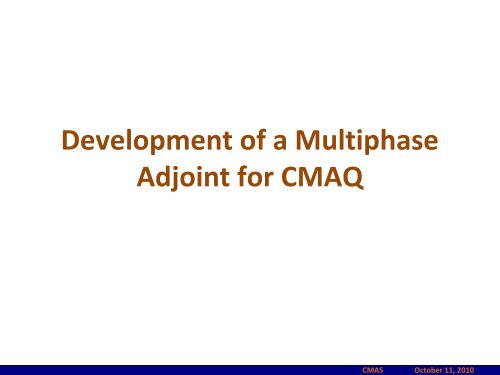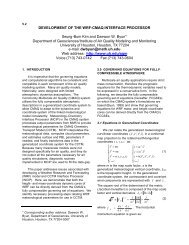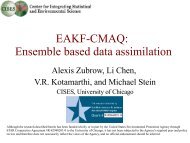Development of a Full Adjoint for CMAQ - CMAS
Development of a Full Adjoint for CMAQ - CMAS
Development of a Full Adjoint for CMAQ - CMAS
You also want an ePaper? Increase the reach of your titles
YUMPU automatically turns print PDFs into web optimized ePapers that Google loves.
<strong>Development</strong> <strong>of</strong> a Multiphase<br />
<strong>Adjoint</strong> <strong>for</strong> <strong>CMAQ</strong><br />
<strong>CMAS</strong> October 11, 2010
The team<br />
• Carleton University (CU): ShunLiu Zhao and Amir Hakami<br />
• Georgia Tech (GT): Shannon Capps, Athanasios Nenes, and Ted<br />
Russell<br />
• University <strong>of</strong> Colorado (UC): Matthew Turner and Daven Henze<br />
• University <strong>of</strong> Houston (UH): Peter Percell<br />
• University <strong>of</strong> Iowa (UI): Jaemeen Baek, Greg Carmichael, and<br />
Charles Stanier<br />
• Virginia Tech (VT): Adrian Sandu<br />
• ICS Prague: Jaroslav Resler<br />
• NOAA: Tianfeng Chai and Daewon Byun<br />
• EPA: Rob Pinder, Sergey Napelenok, and Havala Pye<br />
• Past Contributions from Kumaresh Singh and Tianyi Gou (VT) and<br />
John Seinfeld (Caltech)<br />
<strong>CMAS</strong> October 11, 2010
Outline<br />
• History and background<br />
• Collaboration structure<br />
• Status<br />
– Gas-phase model<br />
– Thermodynamics<br />
– Dynamics<br />
• Outlook<br />
<strong>CMAS</strong> October 11, 2010
Forward vs. backward sensitivity analysis<br />
Inputs/Sources Outputs/Receptors<br />
x<br />
∂ y<br />
∂ x<br />
j<br />
∂ yi ∂ x<br />
• Complementary methods (Source-based vs. Receptor-based), each<br />
suitable <strong>for</strong> specific types <strong>of</strong> problems.<br />
• <strong>Adjoint</strong> useful <strong>for</strong> calculations <strong>of</strong> sensitivities <strong>of</strong> few metrics with respect<br />
to many parameters<br />
• Numerous applications <strong>for</strong> adjoint such as data assimilation and<br />
sensitivity analysis.<br />
y<br />
<strong>CMAS</strong> October 11, 2010
History <strong>of</strong> <strong>CMAQ</strong>-ADJ<br />
• Gas-phase version based on <strong>CMAQ</strong> 4.5.1 was<br />
developed in 2006 (Hakami et al., 2007)<br />
– available <strong>for</strong> download at:<br />
http://people.cs.vt.edu/~asandu/S<strong>of</strong>tware/<strong>CMAQ</strong>_ADJ/<strong>CMAQ</strong>_ADJ.html<br />
• Gas-phase <strong>CMAQ</strong>-ADJ rapidly diverged into multiple<br />
versions<br />
– VT version<br />
• VT/UH version (chemistry update, parallelization, data assimilation<br />
tools)<br />
• ICS Prague version (chemistry update, parallelization, data<br />
assimilation)<br />
– CU/Caltech version (chemistry update, parallelization)<br />
<strong>CMAS</strong> October 11, 2010
History <strong>of</strong> <strong>CMAQ</strong>-ADJ (Cont’d)<br />
• There was a strong need to<br />
– Consolidate versions<br />
– Update to a more recent version <strong>of</strong> <strong>CMAQ</strong><br />
– Include all processes, particularly aerosols<br />
• Funding from the American Petroleum Institute (API)<br />
initiated multi-phase <strong>CMAQ</strong>-ADJ development (CU, GT, UC)<br />
• High level <strong>of</strong> interest and activity among various developer<br />
and user groups resulted in the wider collaborative ef<strong>for</strong>t.<br />
Objective: Develop multi-phase <strong>CMAQ</strong>-ADJ that is based on<br />
latest <strong>CMAQ</strong>, computationally efficient, easy to use, easy to<br />
update, modular, and capable <strong>of</strong> data assimilation and<br />
various types <strong>of</strong> sensitivity analysis<br />
<strong>CMAS</strong> October 11, 2010
Structure<br />
• Aerosol thermodynamics: GT<br />
• Aerosol dynamics: CU and UC<br />
• Aqueous chemistry: UI and EPA<br />
• Data assimilation and gradients: VT, NOAA,<br />
UH, ICS, and CU<br />
• Gas-phase: UH and CU<br />
• Parallelization: UH and ICS<br />
• Nesting: CU<br />
<strong>CMAS</strong> October 11, 2010
<strong>CMAQ</strong>-ADJ<br />
• Based on a hybrid version <strong>of</strong> <strong>CMAQ</strong><br />
– General structure, transport and gas-phase chemistry<br />
based on v4.7.1<br />
– Aerosols based on “alpha” version <strong>of</strong> aerosol<br />
processes in v5.0<br />
• Wanted to have <strong>CMAQ</strong>-ADJ based on latest<br />
release but could not wait <strong>for</strong> v5.0 (2011). This<br />
hybrid version adjoint allows us to quickly update<br />
to v5.0 once it is released.<br />
<strong>CMAS</strong> October 11, 2010
<strong>Adjoint</strong> code development<br />
Isolate the process <strong>of</strong> concern<br />
If the process is too complicated, break down into small<br />
pieces<br />
Develop the adjoint code<br />
– By automatic differentiation<br />
• Requires further code preparation<br />
– Manually<br />
Evaluate on a process-by-process basis<br />
– Finite difference (FD) comparisons<br />
– Complex variable method (CVM)<br />
• Avoid cancellation errors and allow small perturbations
Gas-phase processes<br />
• Updated to v4.7.1<br />
– Adding backward (adjoint) solvers <strong>for</strong> transport module<br />
options not previously supported:<br />
• YAMO advection, but without the “hidden”<br />
modification <strong>of</strong> horizontal wind (using the same<br />
<strong>for</strong>ward and backward solvers <strong>for</strong> horizontal advection<br />
in both PPM and YAMO)<br />
• ACM2 and ACM2_INLINE options <strong>for</strong> vertical diffusion<br />
– To include CB05<br />
– Focusing on adjoint backbone (not gradient<br />
calculation) at the moment<br />
<strong>CMAS</strong> October 11, 2010
Aerosol Processes<br />
<strong>CMAS</strong> October 11, 2010
Aerosol Thermodynamics: ISORROPIA<br />
<strong>CMAS</strong> October 11, 2010
Sample ISORROPIA results<br />
Finite Difference Sensitivity<br />
<strong>CMAS</strong> October 11, 2010
Aerosol Dynamics – example: SOA<br />
Sensitivities <strong>of</strong> SOA mass<br />
w.r.t. J-mode ABNZ2<br />
<strong>CMAS</strong> October 11, 2010
Heterogeneous chemistry<br />
<strong>CMAS</strong> October 11, 2010
Coagulation<br />
<strong>CMAS</strong> October 11, 2010
Aerosol dynamics – all processes<br />
CVM ADJ<br />
Sensitivities <strong>of</strong> all j-mode aerosol mass<br />
w.r.t. j-mode SO4<br />
<strong>CMAS</strong> October 11, 2010
Aerosol dynamics – all processes<br />
CVM ADJ<br />
Sensitivities <strong>of</strong> all j-mode aerosol mass<br />
w.r.t. j-mode NH4<br />
<strong>CMAS</strong> October 11, 2010
Aqueous Chemistry<br />
• Use KPP-generated Rosenbrock solver <strong>for</strong> aqueous<br />
chemistry<br />
– Stay compatible with Carlton et al. (2009)<br />
• Recast the equilibrium reactions as simultaneous<br />
<strong>for</strong>ward and back reactions following Li [2006] and<br />
Kamens et al. [1999].<br />
• Forward (k f ) and backward (k b ) reaction rates should be<br />
– consistent with Henry’s Law and dissociation constants<br />
– fast enough that equilibrium will be reached within a given<br />
time step in the aqueous chemistry module<br />
<strong>CMAS</strong> October 11, 2010
Parallelization<br />
Write I/O operations in <strong>CMAQ</strong> are pre<strong>for</strong>med<br />
serially<br />
Data from all processes are collected to process 0 by calls<br />
<strong>of</strong> MPI routines<br />
Parallelization <strong>of</strong> <strong>CMAQ</strong> is suboptimal and it does not<br />
scale well on large clusters<br />
At the moment, we follow <strong>CMAQ</strong> parallelization<br />
Parallelization <strong>of</strong> <strong>CMAQ</strong> adjoint scales worse than original<br />
<strong>CMAQ</strong> (due to frequent checkpointing), especially <strong>for</strong><br />
large domains with fine resolution.<br />
Other issues: observation operators and minimization in<br />
data assimilation applications<br />
<strong>CMAS</strong> October 11, 2010
1<br />
0.9<br />
0.8<br />
0.7<br />
0.6<br />
0.5<br />
0.4<br />
0.3<br />
0.2<br />
0.1<br />
0<br />
Efficiency <strong>of</strong> parallelization<br />
0 20 40 60 80 100 120 140<br />
Serial writes<br />
(PARIO, local HD)<br />
Parallel efficiency<br />
MPI processes<br />
Serial writes<br />
(PARIO, NFS)<br />
MPI I/O<br />
(Parallel NetCDF)<br />
Multiple files<br />
(NetCDF)<br />
Testing domain: 266x194, 3km resolution<br />
Cluster: AMD Opteron, 152 cores, SAS-2, Infiniband Mellanox<br />
System: OpenSuse11.2, OFED 1.4, MVAPICH2 1.2p1 with Gen2-IB RDMA + SHMEM<br />
Parallelization: From 16 to 132 MPI processes.<br />
Details on the poster Resler et al.: Fine resolution modeling with <strong>CMAQ</strong>-adjoint<br />
<strong>CMAS</strong> October 11, 2010
Current status<br />
• An adjoint model development working session is<br />
scheduled <strong>for</strong> November 12-15. We hope to put<br />
many pieces together at or be<strong>for</strong>e the meeting.<br />
– This will give us a draft version<br />
– Other topics remain:<br />
• Gradients calculation<br />
• 4D-Var tools<br />
• Nesting<br />
• Additional modules in <strong>CMAQ</strong><br />
• Working version to be ready in spring 2011<br />
<strong>CMAS</strong> October 11, 2010
Summary and conclusions<br />
• Majority <strong>of</strong> aerosol subroutines are already differentiated<br />
• Code optimization and efficiency are next<br />
• Next year we will have an operational multi-phase adjoint <strong>for</strong><br />
<strong>CMAQ</strong><br />
• The development is geared towards the user community. If<br />
there are capabilities you like to see in <strong>CMAQ</strong>-ADJ, this is the<br />
time to ask <strong>for</strong> them (amir_hakami@carleton.ca).
• Funding:<br />
Acknowledgements<br />
– API (CU, GT, UC)<br />
– NASA Applied Sciences Program<br />
grant NNX09AN77G (UC)<br />
– ConocoPhillips and NSF Graduate Research<br />
Fellowship (GT)<br />
• Model support:<br />
– USEPA<br />
<strong>CMAS</strong> October 11, 2010




